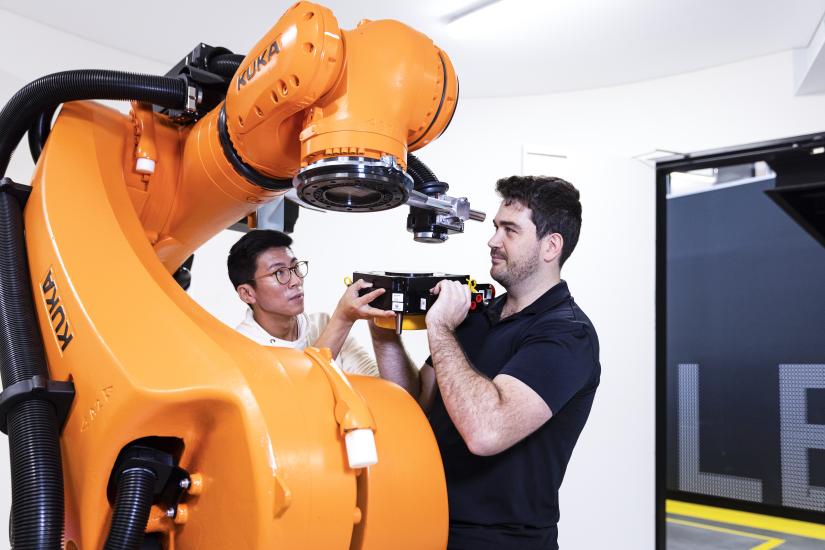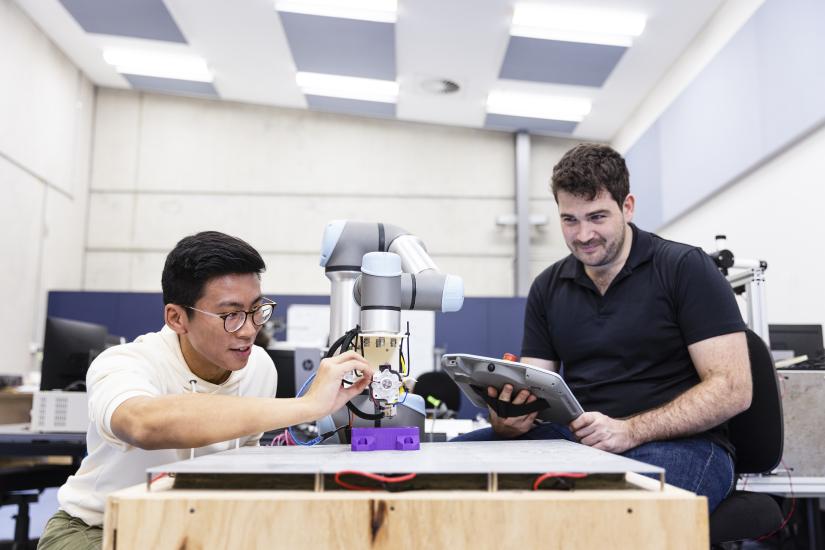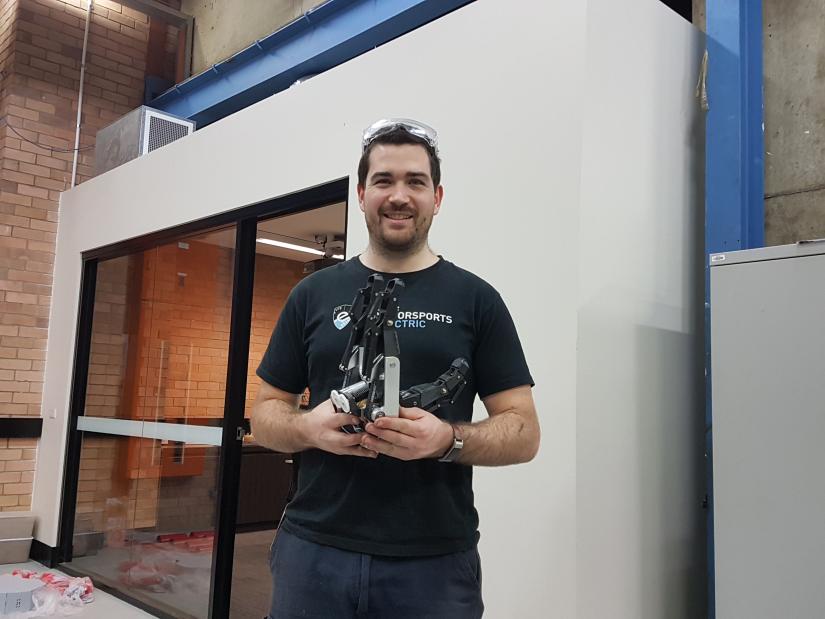
“I have a very sort of obsessive mindset when it comes to solving particular problems,” Clyde Webster, BE DipEngPrac (Mechanical and Mechatronics Engineering) PhD graduand, and Founder of Crest Robotics explained, “I’ll just dwell on them until I find a solution that's satisfactory.”
Through an interview project as part of his PhD, the Tokyo Electric Power Company in Japan had posed to Clyde a particular problem. They needed a solution to address the climbing safety of workers in maintaining power transmission towers.
Clyde had been mulling over possible solutions to this problem and was thinking about it one morning while he waited for his bus to the UTS Tech Lab. Sitting at the bus stop he noticed some myna birds and the way they were hopping on the branches of trees.
Nature and Australia’s natural environment were a formative part of Clyde’s life. His father was a forester, and his mother worked with the national parks. Family camping trips are one of his fondest memories. Growing up close to nature was in sharp contrast to the distance Clyde felt to the high technology world of space travel. “Space as an industry always felt so far away from me and so unreachable in Australia,” Clyde explained. At his young age, space travel felt confined to the same realm of imagination and fantasy found in his favourite childhood books, the His Dark Materials series, and movies, the Star Wars prequels.
Clyde realised that the solution the Tokyo Electric Power Company needed would have to involve robots—but what kind of robots could be built to scale and balance on power transmission towers, to reach and grab, and nimbly perform the constant repetitive motion needed?
The myna bird sparked an idea and then he noticed that lorikeets and cockatoos walk around rather than hopping like a myna bird, “...they're very slow and deliberate and they use their beak as they walk.”
Psittacine—the species of birds that encompass lorikeets, cockatoos, and parrots—use their beaks in a unique way. “They clamber instead of hop, and they use their beak, not just as a way to pick up things, but like an actual arm to grab and pull.”
Most may think of climbing creatures in terms of quadrupedal animals, like monkeys or squirrels, with four limbs and grasping hands and feet. A climbing robot based on a quadruped would similarly be grasping at four points of contact, but if the robot needed to extend one of its limbs to its fullest reach, it would have to let go of the opposite limb. Clyde reasoned, “...if it needed to let go of the opposite limb, and it as fully capable of doing so, what was the point of having that limb?”

In contrast, the tripedal way that parrots climb with their two feet and one beak, would inform a climbing motion in robots that particularly suited instances where the third limb, based on the beak, could shift into a grabbing or pulling mechanism with greater reach, mobility, and balance. “It's less complex, it has lower mass and the form allows you to do more work than moving around.” Clyde felt he had finally found an ideal starting point in the design of climbing robots that could be used to perform laborious tasks on tall structures, like the Tokyo Electric Power Company’s transmission towers.
"I wondered if I could find anything on parrot mechanics or parrot climbing, and to my dismay, there was nothing, the whole field of literature is absolutely barren.” His research led him to Professor Anick Abourachid in Paris who was also studying the neck morphology of birds. “Professor Abourachid was the only other person in the world that was sort of looking at anything related to neck morphology in birds and how that might be useful.”
Soon after his discussions with Professor Abourachid and other biologists, Clyde began his own experiments, placing cockatiels at the bottom of a ladder and filming them climbing up. “I changed the angle and I observed at 45 degrees on the ladder they could just walk up, but slowly, as I added more degrees to the angle, they used their beak more and more.” Clyde was confident he could duplicate this type of tripedal movement in robots with today’s technology. “There's a lot of impressive robotics companies out there that show that we've got the understanding of the physics, and the availability of electronics and hardware. Building these kinds of robots is now an accessible thing, which wasn’t the case even maybe five years ago.”
Clyde studied “whole body dynamic control,” which he described as a very different robotic control paradigm allowing more fluid motion and more dynamic action than is found in rigid traditional robots. In seeking out knowledge resources for body dynamic control, Clyde’s PhD supervisor, Professor Robert Fitch, connected Clyde to William Reid, a Robotics Technologist who was not only an expert in the field, but also someone who would offer Clyde an unexpected, once-in-a-lifetime opportunity. At NASA.
William Reid worked in NASA’s Jet Propulsion Laboratory. Clyde recalled, “We had an hour-long call where I just told him about what I'm doing and what I was struggling with and what I need help with and he gave me some pointers in the right direction and at the end of the meeting he said, ‘If you want an internship at NASA, just let me know.’”

Having once felt, as a young boy, that outer space and NASA were concepts too fantastic to even be dreamt about, Clyde found himself observing the landing of the Perseverance Rover on Mars with his new colleagues as an intern at NASA. “Even sitting as a fly on the wall at the events where they celebrated landing a car-sized Rover on Mars was just amazing”
His internship at NASA now complete, Clyde is currently contracting with Australian spacecraft builder, The Space Machines Company, helping with the design of an orbital transfer vehicle, and he has founded his own robotics company, Crest Robotics, which has created a parrot-robot prototype that has recently taken its first steps. While the spark that inspired the design of the robot was a bird in nature, Clyde’s mission with Crest Robotics is deeply human—the safety and well-being of people in the workforce.
“We look at the work that's out there and we see repetitive tool-based labour, especially in dangerous situations. That's things like using sandblasters or angle grinders or jackhammers. These are repetitive tasks that are causing people harm, especially in strain sort of injuries. It’s cutting careers short because these are really demanding tasks that just can't be done for a span of 20-30 years. I really want to enable people to work careers their entire lives, and have the robots do the really repetitive, dangerous, and damaging things.”
For more information, visit Crest Robotics.

